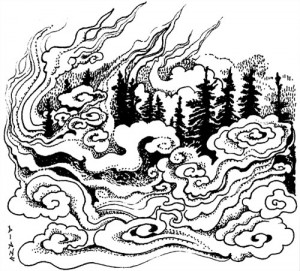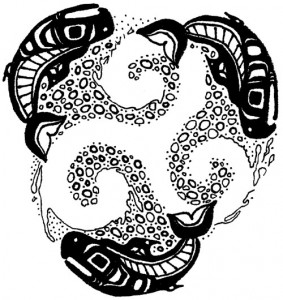
A Mystery at Beaver Lake, Illustration by Diane Wood
Jean and I often go to Beaver Lake in Stanley Park. We go in the morning to feel the quietness of the lake, and to avoid the crowds that come to the park in the afternoon.
One morning we were standing on the wooden platform at the north end of Beaver Lake, watching the ducks swim among the water lilies. A faint mist covered the south end of the lake, and the trees appeared and disappeared in the mist. Jean, whose eyes are better than mine, said, “There’s something at the south end of the lake that looks strange.”
“I can’t see anything, especially with this mist,” I replied. “Where should I look?”
“Look in the direction of the place where we picked a ripe blueberry on May 25th last year,” Jean said.
“I remember. You gave me the blueberry as a birthday present. I see only mist there now.”
“Be patient,” Jean said. “The mist will move away, and then you have to watch for something that doesn’t belong there.”
The mist curled gracefully among the trees, revealing the place where we had found the ripe blueberry. I saw a grey shape about six feet tall. It was absolutely still.
“Am I looking at an abominable snowman?” I asked.
“No, not here,” Jean replied. “Let’s move closer,” and we walked south on the path on the west side of Beaver Lake. “It seems to have feathers,” Jean whispered as we got closer to this strange apparition.
“It looks like it’s been painted on a piece of wood.”
“It doesn’t seem to have a head, and it’s not six feet tall. The mist made it look bigger,” I whispered back to Jean as though we were in church. From this point on, we would move as quietly as the mist that was disappearing as the sun rose higher in the sky.
We walked slowly, stealthily, and deliberately toward the mystery. We could see that it was between four and five feet tall, blue-grey in colour, and it had magnificent feathers on its back and neck.
“I see its head,” Jean said. “It’s tucked between its shoulders, and its bill is pointing away from us.”
“A heron!” I exclaimed. “A Great Blue Heron! The biggest one I’ve ever seen. He’s standing on his own land as if he has stood there forever.”
“Herons have lived on this earth a lot longer than humans,” Jean said.
“Yes,” I replied, “and the oldest known heron colony in British Columbia is right here in Stanley Park. But today the herons are a species at risk.”
“How beautiful you are,” Jean said to the heron.
Just then the heron moved its head, and we could see its long dagger bill. It spread its enormous wings, and with a harsh, croaking cry, it lifted itself into the air and circled the lake. With its long neck folded back, its legs trailing behind it, and its powerful wings flapping slowly, it looked like an ancient messenger from long ago when the earth was young. “Your destiny is connected to mine,” it seemed to be telling us. “If you destroy my living space, you will destroy your own.”
We watched the heron disappear in the forest, and we were left with its message and the memory of what we had seen.
“He is our older brother,” I said.
“We have to change the way we live,” Jean said.
~ by Sandy Cameron

